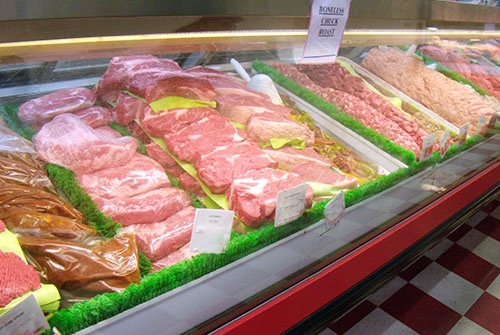Why Residents Love Bagley Farms Meat Market Edwardsville IL for Their Meat Buying
Why Residents Love Bagley Farms Meat Market Edwardsville IL for Their Meat Buying
Blog Article
Discover the Art of the Butcher's Cut in a Modern Meat Market
In the ever-evolving landscape of modern meat markets, the butcher's cut has transcended its typical roots, combining age-old workmanship with contemporary techniques. What genuinely sets the modern butcher apart is their capability to create a much deeper connection in between consumers and the origins of their meat.
Evolution of Butchery Strategies

The mid-20th century saw butchery strategies additionally fine-tuned by scientific insights right into muscle mass biology and meat aging, improving both tenderness and preference. Technologies like vacuum cleaner packaging and refrigeration extended item shelf-life, permitting butchers to branch out offerings and improve quality assurance. This duration also noted the increase of specialized tools, such as band saws and meat slicers, which raised precision and efficiency in meat handling.
Electronic systems currently aid in monitoring animal provenance and maximizing cuts to meet specific client preferences. Additionally, a renewal in artisanal butchery has actually emerged, blending conventional abilities with contemporary knowledge to provide to consumers looking for moral and lasting meat alternatives.

Comprehending Meat Cuts

Comprehending the complexities of meat cuts is vital for both butchers and consumers seeking quality and worth. Each cut comes from a different component of the pet, giving distinct flavors, appearances, and food preparation techniques. Mastery of these distinctions not only enhances cooking experiences however also takes full advantage of the utility of each carcass. For butchers, precise cuts mirror skill and regard for the craft, making sure minimal waste and optimum return.
The main groups of meat cuts include primitive, sub-primal, and retail cuts. Butchers then damage these down further into sub-primal cuts, prior to finally creating retail cuts available to customers, like ribeye or tenderloin.
Comprehending muscle mass make-up is important; muscular tissues used a lot more regularly by the animal have a tendency to be harder and are best matched for slow cooking techniques, while less-used muscular tissues, like those found in the loin, are a lot more tender and perfect for grilling or roasting. Experience with these distinctions encourages customers to make enlightened choices, improving their cooking undertakings.
Selecting Quality Meat
Selecting the right meat entails even more than just selecting a visually appealing item from the screen. The art of selecting top quality meat needs a critical eye and understanding of particular attributes that indicate freshness and quality.
Second of all, consider the marbling, which describes the white flecks of fat within the muscle. Correct marbling is a crucial indicator of inflammation and flavor, as it thaws during food preparation, improving the meat's juiciness. Remember, greater marbling typically correlates with superior quality cuts, such as USDA Prime.
Appearance is one more critical aspect; meat ought to feel solid to the touch, not slimed or excessively soft. Additionally, bear in mind the scent. Fresh meat needs to have a clean, neutral smell, devoid of any sour or repulsive smells.
Matching Cuts With Food Preparation Techniques
Successfully combining cuts of meat with the suitable food preparation methods is essential for attaining ideal flavor and appearance. Different cuts differ in tenderness, marbling, and connective cells material, each requiring certain strategies to unlock their capacity. As an example, tender cuts like filet mignon and ribeye, with their inherent marbling, advantage from high-heat, quick-cooking methods such as barbecuing or pan-searing. These methods improve the meat's natural tastes visit the site and make sure a juicy coating.
Alternatively, harder cuts like brisket and chuck roast are abundant in collagen, which breaks down into gelatin when cooked slowly. These cuts are perfect for braising or slow-moving roasting, allowing the meat to tenderize in time and develop deep, intricate flavors. Similarly, cuts such as short ribs and pork shoulder prosper with slow-cooking approaches, where expanded cooking times change their durable structures into delicious recipes.
Lamb shanks and oxtail, which require extended cooking to soften, are excellent prospects for cooking or sluggish simmering. These techniques coax out rich, passionate flavors while preserving moisture. By recognizing the special attributes of each cut, chefs and home chefs alike can raise their culinary productions, making certain each meal is both satisfying and remarkable.
The Butcher's Function Today
Navigating the advancing landscape of the modern meat market, the butcher's duty today extends beyond plain preparation of cuts. Contemporary butchers are cooking craftsmens, educators, and supporters for lasting practices.
In enhancement to crafting specific cuts, butchers now involve straight with customers, using cooking suggestions and tailoring choices to match individual requirements and choices. Their experience in meat aging, marbling, and flavor accounts encourages consumers to make enlightened choices, enhancing their culinary experiences. This individualized solution exemplifies the butcher's progressing duty as a relied on advisor in the kitchen area.
In addition, butchers are pivotal in lessening waste, utilizing whole pets to create varied items such as sausages best site and stocks - bagley farms meat market edwardsville il. This extensive technique not just respects the animal yet also aligns with contemporary sustainability goals. In this method, the modern butcher personifies both practice and innovation, adapting to an ever-changing market while preserving the artistry and integrity of their craft

Verdict
The Extra resources modern butcher's craft intricately weaves traditional methods with modern technologies, highlighting sustainable techniques and honest sourcing. Proficiency in comprehending diverse meat cuts and top quality signs empowers butchers to provide educated recommendations, straightening particular cuts with optimal food preparation methods. This expertise not just elevates cooking experiences however also enhances the connection in between customers and the origins of their food. By recognizing historical methods while embracing modern demands, the butcher's function remains essential in today's advanced meat market.
Report this page